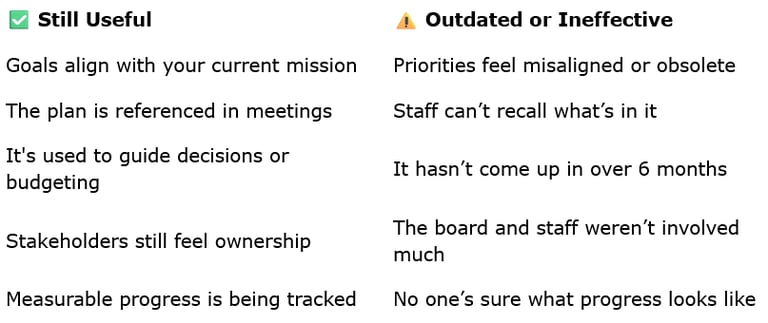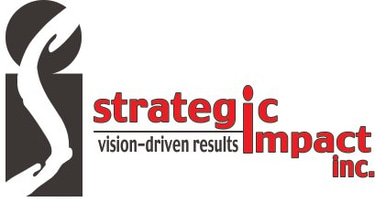How to Know if Your Strategic Plan Is Still Useful
If you’ve ever said: “We have a strategic plan, but no one looks at it.” “It’s collecting dust on a shelf.” “Our plan was great… three years ago.” You’re not alone.
Sheryl Foster
6/17/20253 min read
If you’ve ever said:
“We have a strategic plan, but no one looks at it.”
“It’s collecting dust on a shelf.”
“Our plan was great… three years ago.”
You’re not alone. A study by the Bridgespan Group found that while most nonprofits create strategic plans, far fewer actually use them as dynamic tools.
Why? Because even strong plans can quickly lose relevance if they aren’t regularly revisited and reconnected to day-to-day operations.
Is Your Plan Outdated or Still Useful?
Ask yourself and your team:
If most of your answers fall on the right side of the table, it’s time for a plan refresh.
3 Steps to Revive or Realign Your Strategic Plan
If your plan feels more like a document on a shelf than a guide in action, you’re not alone. The good news? You don’t need to start from scratch. With a few intentional steps, you can breathe new life into your plan and reconnect it to your current reality. Here’s how to get started.
Step 1. Start with a Readiness Check
Before jumping into planning mode, assess whether your organization is truly ready.
Key questions include:
Do you have leadership and board alignment?
Is there capacity (time, energy, budget) to engage?
Are you committed to implementing or revisiting the plan?
👉 Use this Strategic Planning Readiness Checklist to evaluate where you stand.
Step 2. Reground in Mission and Reality
Pull your existing plan off the shelf and ask:
Does this reflect who we are today? Your mission might be the same, but your programs, partnerships, or community priorities may have shifted. If your plan still speaks to a version of your organization that no longer exists, it’s time to revisit it.
Has our external environment changed (funding, partners, needs)? Consider shifts in funding streams, policy changes, community needs, or even new partnerships. The post-pandemic landscape, for example, introduced permanent changes in how services are delivered and how funders measure impact.
What’s working, and what needs to be retired? Some goals may be complete, while others have stalled or become irrelevant. Use this opportunity to identify what should be celebrated, adjusted, or let go entirely. A good strategic plan is a living tool, not a static document.
According to BoardSource, boards that regularly revisit strategy are better positioned to navigate change, especially during periods of disruption. When strategy becomes a habit, not just an event, you build resilience into your organization’s culture.
Step 3. Reconnect the Plan to Daily Decisions
Planning is only valuable if it’s lived out. A strategic plan isn’t a trophy; it’s a tool. Too often, organizations spend months creating a thoughtful, ambitious plan only to let it fade from memory once it's finalized.
To ensure your strategy drives real impact, it must be integrated into the rhythms of your organization. Build habits that keep strategy top-of-mind. These habits could include reviewing the plan quarterly with your team and board. Strategy is an ongoing conversation. Embedding strategic priorities into regular meetings keeps goals top-of-mind, surfaces challenges early, and ensures decisions stay aligned with your broader direction. When strategy becomes part of your organizational routine, it shifts from a one-time event to a guiding force in day-to-day leadership.
Furthermore, tie budgets and new initiatives back to strategic goals to ensure alignment between your resources and your mission. Every dollar spent and every new program launched should support the outcomes your organization is working toward. When funding decisions and project proposals are evaluated through the lens of your strategic plan, it becomes easier to prioritize effectively, justify investments to funders and stakeholders, and avoid mission drift. This alignment transforms your plan from a static document into a practical decision-making tool.
Celebrate wins and adapt when something isn’t working to keep momentum and learning at the center of your strategy. Recognizing progress, whether it’s a completed goal, a successful program milestone, or improved team collaboration, boosts morale and reinforces commitment. At the same time, being honest about what’s not working creates space for course correction without blame. A flexible, learning-oriented approach ensures your strategy evolves with your organization and the environment around it, keeping it both relevant and effective.
As La Piana Consulting notes, today’s nonprofit strategies need to be adaptive, not static. Embedding strategy into decision-making, funding, and culture helps transform your plan from a document into a driver of mission success.
Ready to Refresh Your Plan?
Whether you’re due for a tune-up or a full overhaul, starting with reflection is the best first step.
👉 Download the Strategic Planning Readiness Checklist
👉 Or book a free discovery consult to talk through where your organization stands.
Your mission deserves a plan that moves with it. Let’s make sure your strategy stays in motion.


Impact
Supporting nonprofits to achieve their goals effectively.
Contact
info@vision-driven.com
+1-314-249-6848
© 2025. All rights reserved.
Substack - https://esherylaccount.substack.com/
Fill out the form below and I will be right with you.
